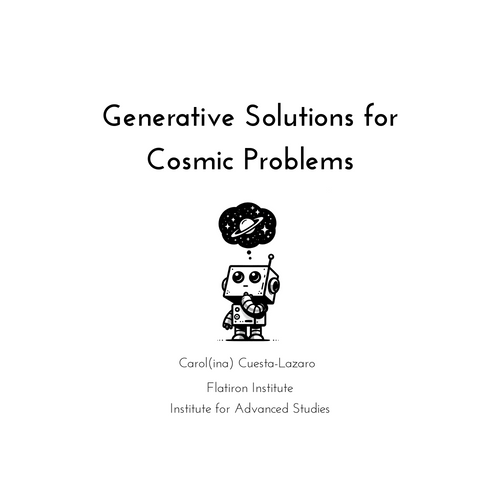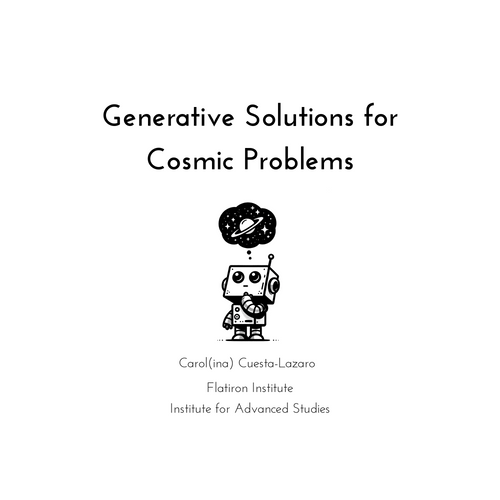Cosmology's Midlife Crisis
IAIFI Fellow, MIT

Carolina Cuesta-Lazaro
Art: "A Bar at the Folies-Bergère" by Édouard Manet

Embracing the Machine Learning Makeover

["DESI 2024 VI: Cosmological Constraints from the Measurements of Baryon Acoustic Oscillations" arXiv:2404.03002]

What role did Machine Learning play?
Dark Energy is constant over time
DESI's Dark Energy constraints
Carolina Cuesta-Lazaro IAIFI/MIT @ University of Tokyo 2024


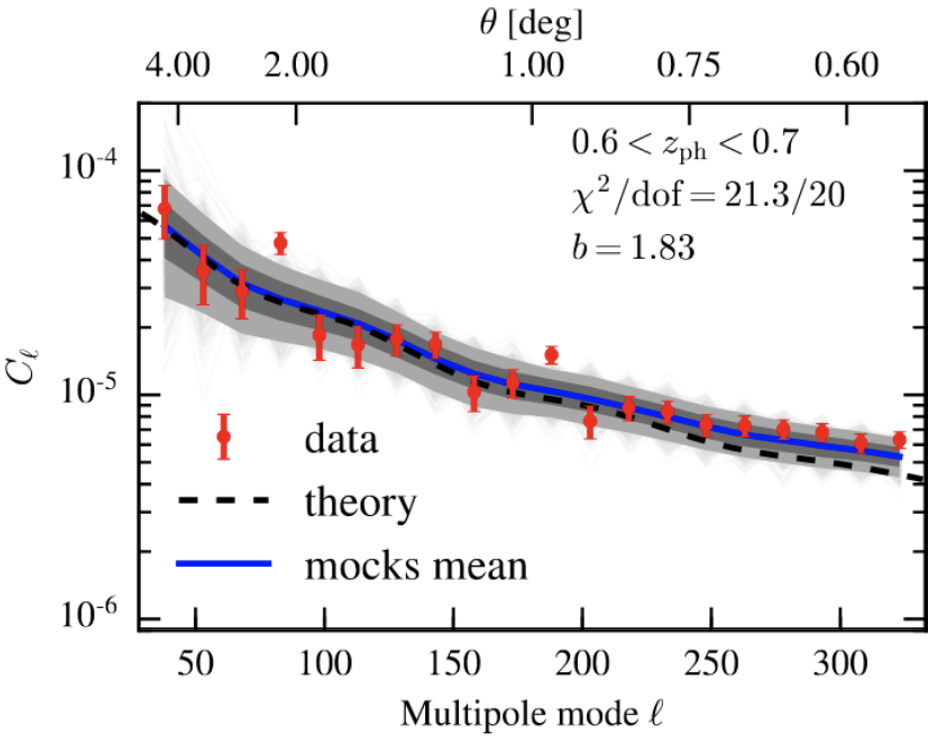

1-Dimensional



Machine Learning
Secondary anisotropies
Galaxy formation
Intrinsic alignments



DESI, DESI-II, Spec-S5
Euclid / LSST
Simons Observatory
CMB-S4
Ligo
Einstein


The era of Big Data Cosmology
xAstrophysics
5-Dimensional
Carolina Cuesta-Lazaro IAIFI/MIT @ University of Tokyo 2024

Dataset Size = 1
Can't poke it in the lab

Simulations
Bayesian statistics
Cosmology is hard
Carolina Cuesta-Lazaro IAIFI/MIT @ University of Tokyo 2024










Astrophysics dominates Simulation-based Inference
Carolina Cuesta-Lazaro IAIFI/MIT @ University of Tokyo 2024
Unicorn land The promise of ML for Cosmology
Reality Check Roadblocks & Bottlenecks

Outline of this talk
Mapping dark matter
Reverting gravitational evolution
Learning to represent baryonic feedback
Data-driven hybrid simulators
Unsupervised problems
Fast Emulators + Compression + Field Level Inference
Carolina Cuesta-Lazaro IAIFI/MIT @ University of Tokyo 2024

[Image Credit: Claire Lamman (CfA/Harvard) / DESI Collaboration]
Carolina Cuesta-Lazaro IAIFI/MIT @ University of Tokyo 2024
The cost of cosmological simulations
AbacusSummit
330 billion particles in 2 Gpc/h volume
60 trillion particles
~ 8TBs per simulation

15M CPU hours
(TNG50 ~100M cpu hours)
ML Requirements

WANTED
Fast field level emulators
Compression methods
Likelihood estimators
Simulation efficient methods
Carolina Cuesta-Lazaro IAIFI/MIT @ University of Tokyo 2024
Model


Training Samples









Generative Models 1o1
Evaluate probabilities


Low p(x)
High p(x)

Generate Novel Samples


Carolina Cuesta-Lazaro IAIFI/MIT @ University of Tokyo 2024
Probability mass conserved locally
Inference a la gradient descent

1) Tractable
2) f maximally expressive
Loss = Maximize likelihood training data
Carolina Cuesta-Lazaro IAIFI/MIT @ University of Tokyo 2024
In continuous time
Continuity Equation
Loss requires solving an ODE!
Diffusion, Flow matching, Interpolants... All ways to avoid this at training time
[Image Credit: "Understanding Deep Learning" Simon J.D. Prince]
Carolina Cuesta-Lazaro IAIFI/MIT @ University of Tokyo 2024
Can we regress the velocity field directly?
Turned maximum likelihood into a regression problem!
Interpolant
Stochastic Interpolant
Expectation over all possible paths that go through xt
["Stochastic Interpolants: A Unifying framework for flows and diffusion" Albergo et al arXiv:2303.08797]
Carolina Cuesta-Lazaro IAIFI/MIT @ University of Tokyo 2024
Diffusion Models
Reverse diffusion: Denoise previous step
Forward diffusion: Add Gaussian noise (fixed)




Prompt
A person half Yoda half Gandalf
Denoising = Regression
Fixed base distribution:
Gaussian
Carolina Cuesta-Lazaro IAIFI/MIT @ University of Tokyo 2024

["A point cloud approach to generative modeling for galaxy surveys at the field level"
Cuesta-Lazaro and Mishra-Sharma
ICML AI4Astro 2023, arXiv:2311.17141]
Base Distribution
Target Distribution
- Sample
- Evaluate
Long range correlations
Huge pointclouds (20M)
Homogeneity and isotropy

Siddharth Mishra-Sharma
Carolina Cuesta-Lazaro IAIFI/MIT @ University of Tokyo 2024
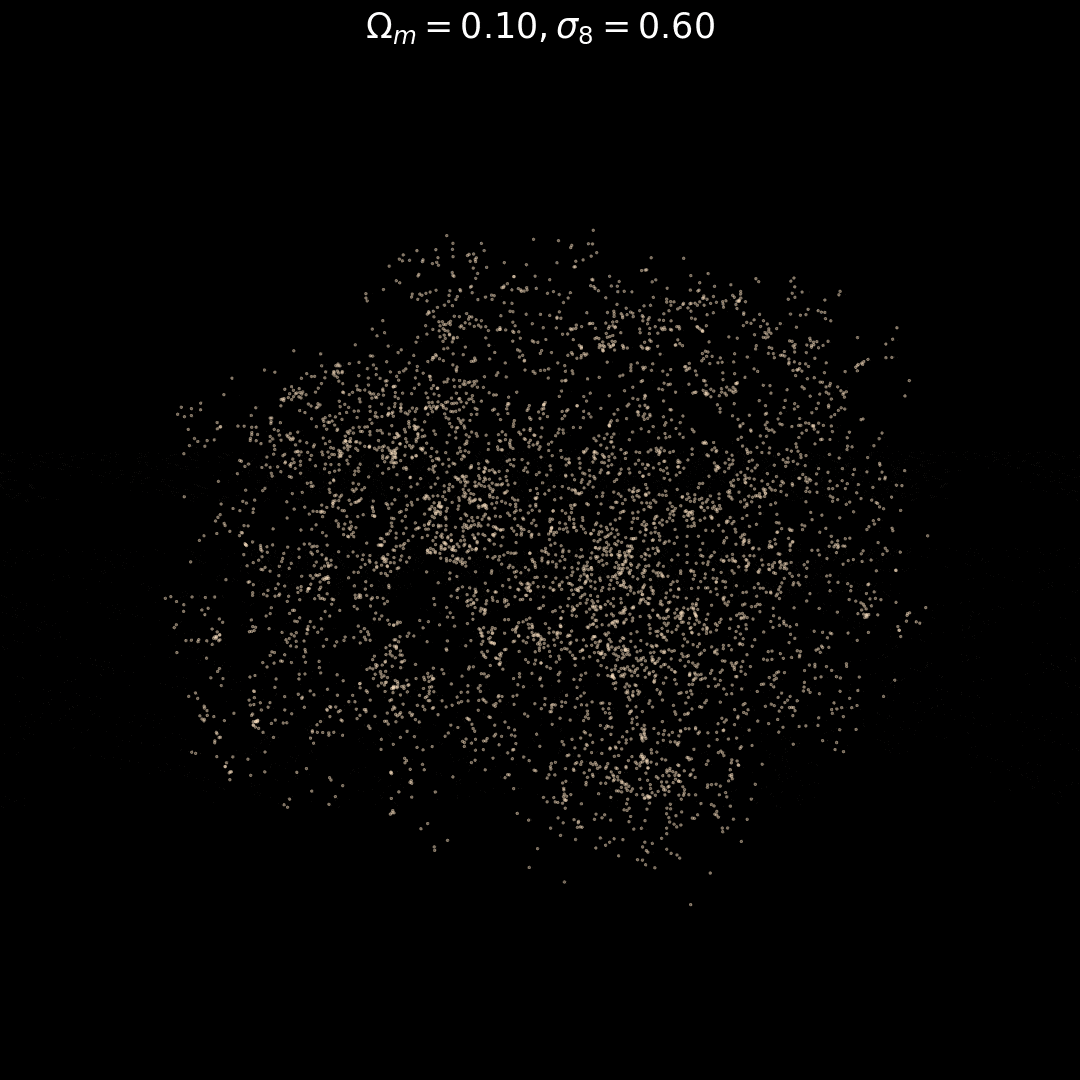
Fixed Initial Conditions / Varying Cosmology
Carolina Cuesta-Lazaro IAIFI/MIT @ University of Tokyo 2024

Diffusion model
Carolina Cuesta-Lazaro IAIFI/MIT @ University of Tokyo 2024
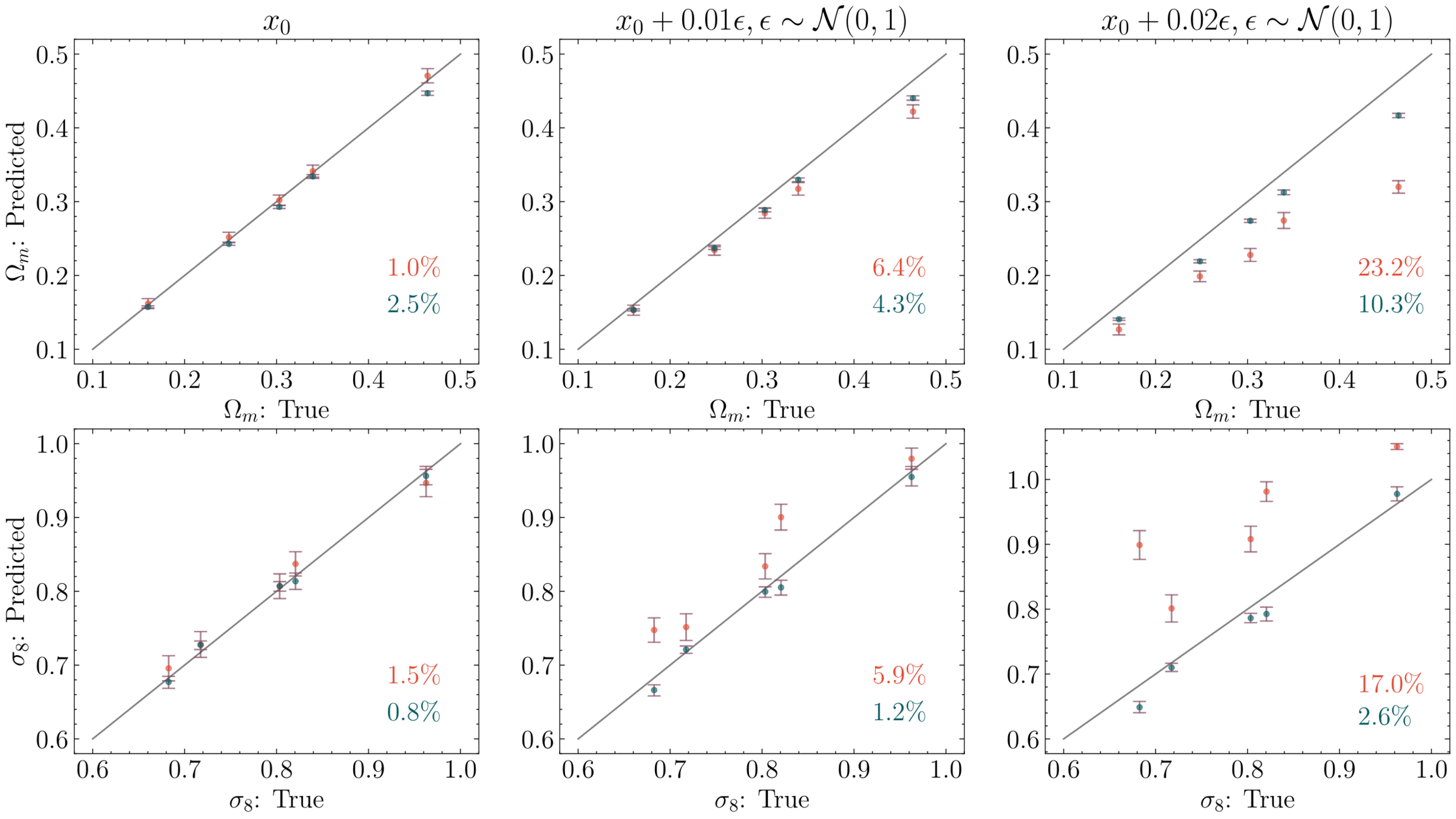
CNN
Diffusion
Increasing Noise
["Diffusion-HMC: Parameter Inference with Diffusion Model driven Hamiltonian Monte Carlo" Mudur, Cuesta-Lazaro and Finkbeiner NeurIPs 2023 ML for the physical sciences, arXiv:2405.05255]

Nayantara Mudur


CNN
Diffusion
Carolina Cuesta-Lazaro IAIFI/MIT @ University of Tokyo 2024
["A Cosmic-Scale Benchmark for Symmetry-Preserving Data Processing"
Balla, Mishra-Sharma, Cuesta-Lazaro et al
NeurIPs 2024 NuerReps arXiv:2410.20516]

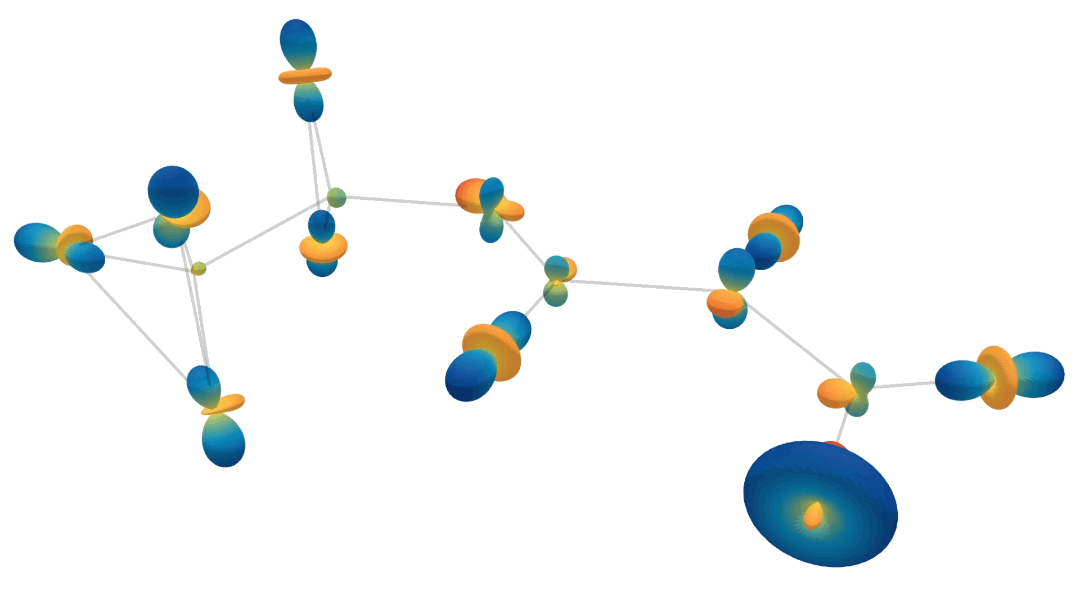
E(3) Equivariant architectures
Benchmark models
["Geometric and Physical Quantities Improve E(3) Equivariant Message Passing" Brandstetter et al arXiv:2110.02905]
Symmetry-preserving ML
Carolina Cuesta-Lazaro IAIFI/MIT @ IPMU 2024
The bitter lesson by Rich Sutton
The biggest lesson that can be read from 70 years of AI research is that general methods that leverage computation are ultimately the most effective, and by a large margin. [...]
methods that continue to scale with increased computation even as the available computation becomes very great. [...]
We want AI agents that can discover like we can, not which contain what we have discovered.
Carolina Cuesta-Lazaro IAIFI/MIT @ IPMU 2024

["A Cosmic-Scale Benchmark for Symmetry-Preserving Data Processing"
Balla, Mishra-Sharma, Cuesta-Lazaro et al
NeurIPs 2024 NuerReps arXiv:2410.20516]
Carolina Cuesta-Lazaro IAIFI/MIT @ IPMU 2024
Memory scaling point clouds and voxels
Graph
Nodes
Edges
3D Mesh
Voxels
Both data representations scale badly with increasing resolution
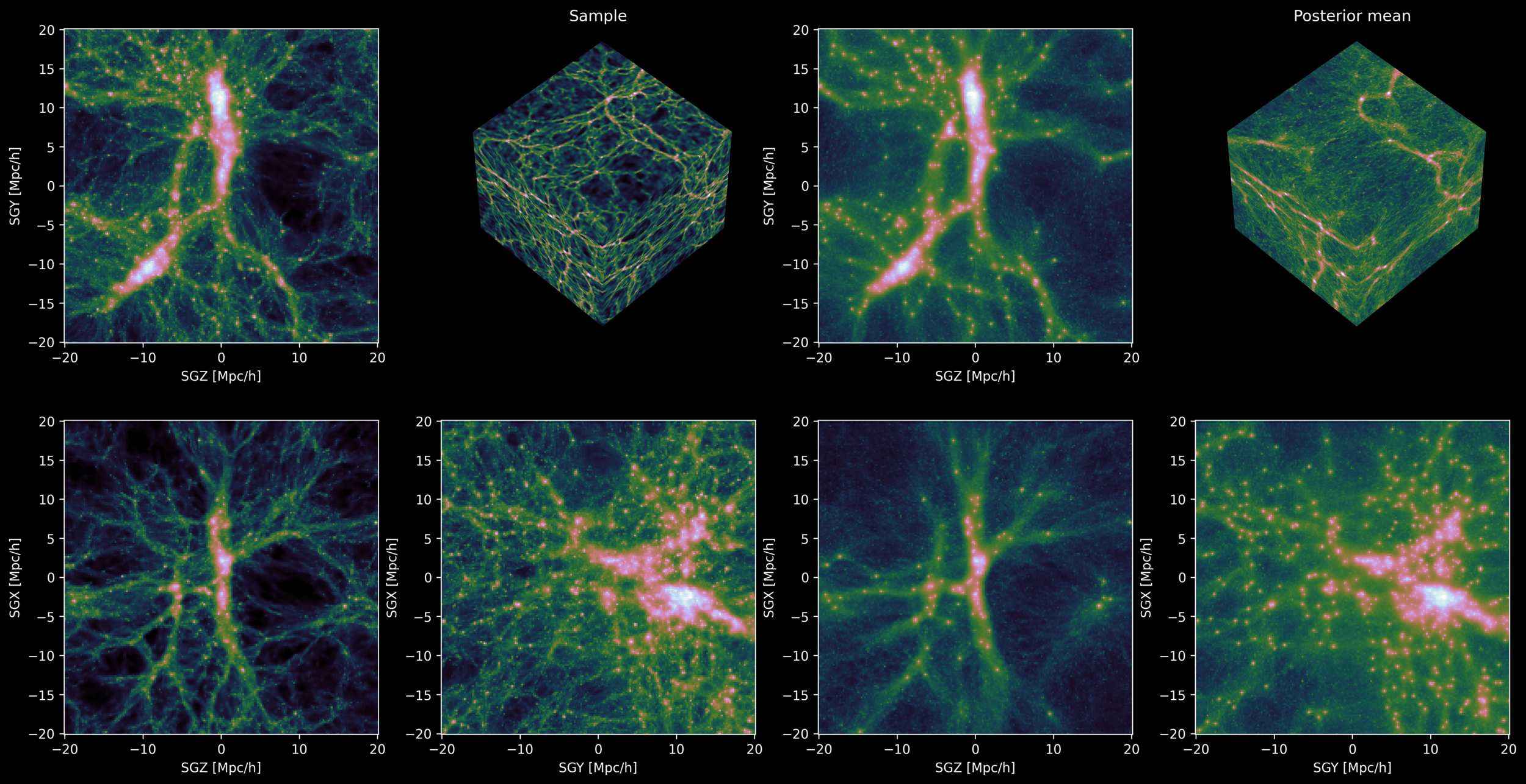
Carolina Cuesta-Lazaro IAIFI/MIT @ IPMU 2024
Representing Continuous Fields

Continuous in space and time

x500 Compression!
Carolina Cuesta-Lazaro IAIFI/MIT @ IPMU 2024
#Recap
More than fast emulators:
Robust field-level likelihood models
Need to compress data:
Continuous fields ~1000?
Need to improve data efficiency:
Incorporating symmetries helps



Carolina Cuesta-Lazaro IAIFI/MIT @ IPMU 2024
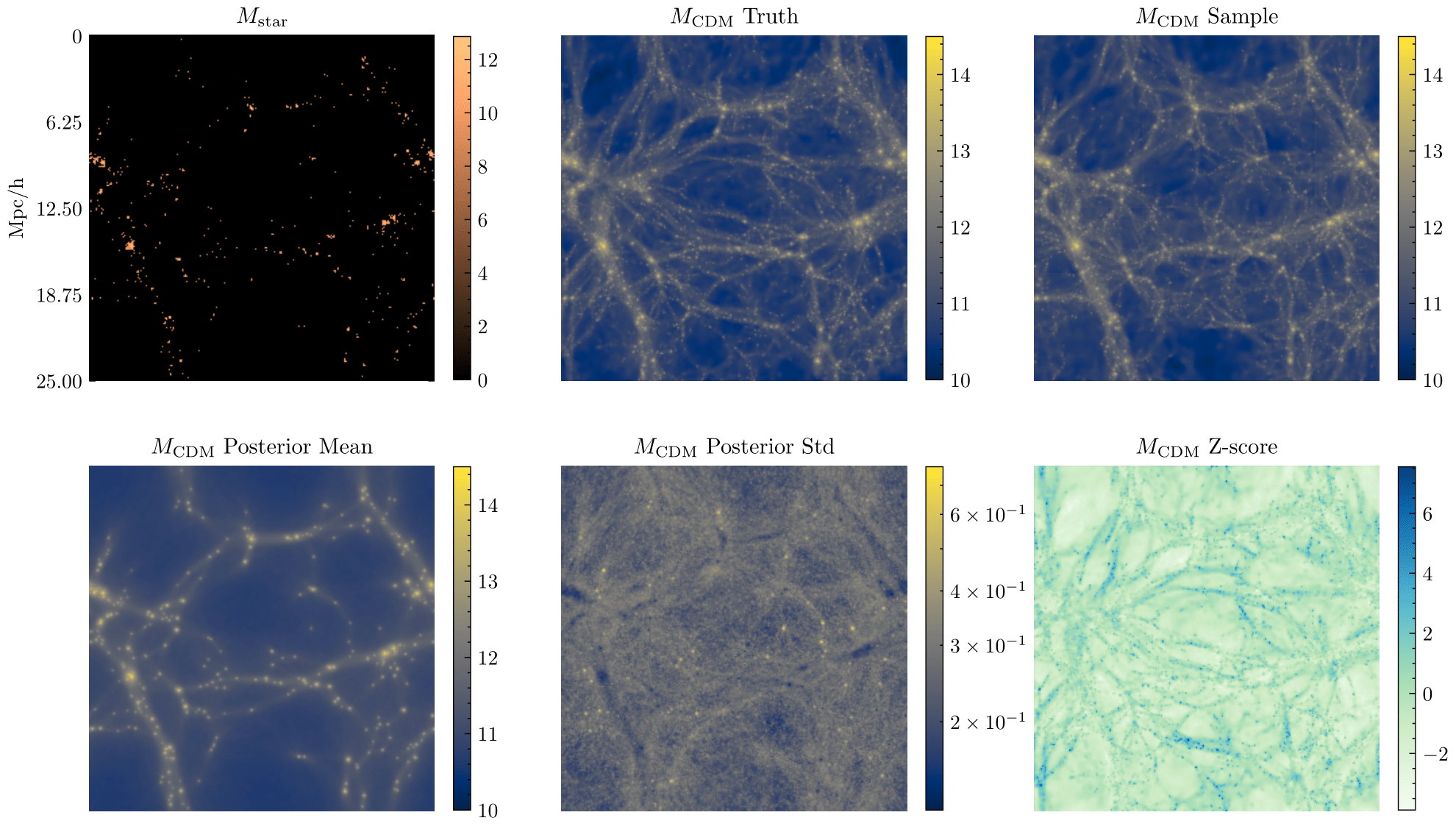
1 to Many:
Galaxies
Dark Matter

["Debiasing with Diffusion: Probabilistic reconstruction of Dark Matter fields from galaxies"
Ono et al (including Cuesta-Lazaro)
NeurIPs 2024 ML for the physical Sciences arXiv:2403.10648]

Victoria Ono
Core F. Park
Generative Models for Inverse Problems

Carolina Cuesta-Lazaro IAIFI/MIT @ IPMU 2024


Truth
Sampled


Observed
Small
Large
Scale (k)
Power Spectrum
Small
Large
Scale (k)
Cross correlation
Carolina Cuesta-Lazaro IAIFI/MIT @ IPMU 2024
TNG-300
True DM
Sample DM
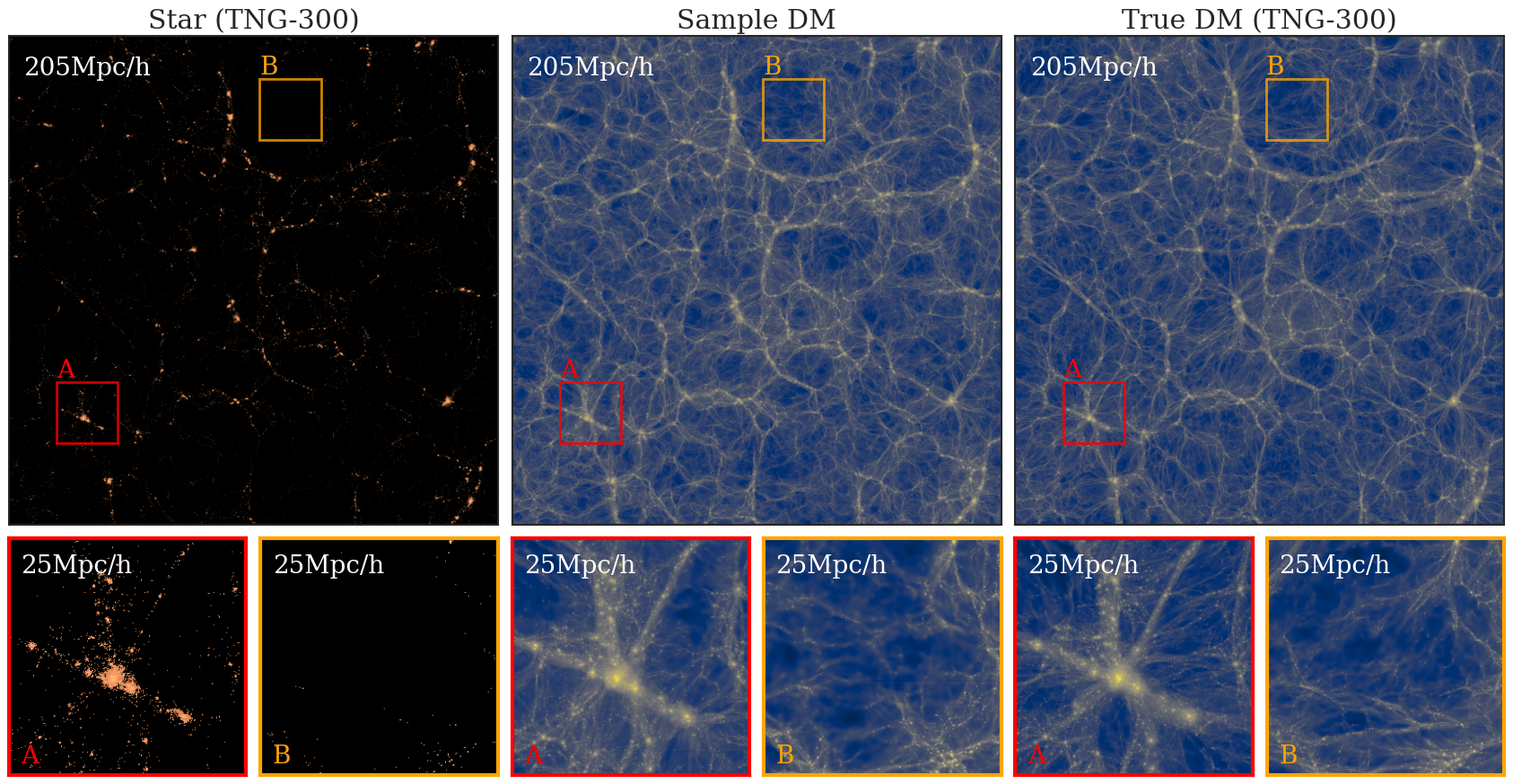



Size of training simulation
1) Generalising to larger volumes
Model trained on Astrid subgrid model
2) Generalising to subgrid models
Carolina Cuesta-Lazaro IAIFI/MIT @ IPMU 2024

["3D Reconstruction of Dark Matter Fields with Diffusion Models: Towards Application to Galaxy Surveys" Park, Mudur, Cuesta-Lazaro et al ICML 2024 AI for Science]
Posterior Sample
Posterior Mean
Debiasing Cosmic Flows
Carolina Cuesta-Lazaro IAIFI/MIT @ IPMU 2024
Reconstructing dark matter back in time
Stochastic Interpolants
NF


["Joint cosmological parameter inference and initial condition reconstruction with Stochastic Interpolants" Cuesta-Lazaro, Bayer, Albergo et al NeurIPs 2024 ML for the Physical Sciences]
Carolina Cuesta-Lazaro IAIFI/MIT @ IPMU 2024





?
["Probabilistic Forecasting with Stochastic Interpolants and Foellmer Processes" Chen et al arXiv:2403.10648 (Figure adapted from arXiv:2407.21097)]

Generative SDE
Carolina Cuesta-Lazaro IAIFI/MIT @ IPMU 2024
Carolina Cuesta-Lazaro IAIFI/MIT @ IPMU 2024
Guided simulations with fuzzy constraints

Simulate what you need
(and sometimes what you want)
Carolina Cuesta-Lazaro IAIFI/MIT @ IPMU 2024
Simulate what you need
(and sometimes what you want)

["Joint cosmological parameter inference and initial condition reconstruction with Stochastic Interpolants" Cuesta-Lazaro, Bayer, Albergo et al NeurIPs 2024 ML for the Physical Sciences]
Carolina Cuesta-Lazaro IAIFI/MIT @ IPMU 2024

How do we learn what is the robust information?

Simulating dark matter is easy!
"Atoms" are hard" :(
N-body Simulations
Hydrodynamics
Can we improve our simulators in a data-driven way?
How well can we simulate the Universe?
(if cold!)
Carolina Cuesta-Lazaro IAIFI/MIT @ IPMU 2024

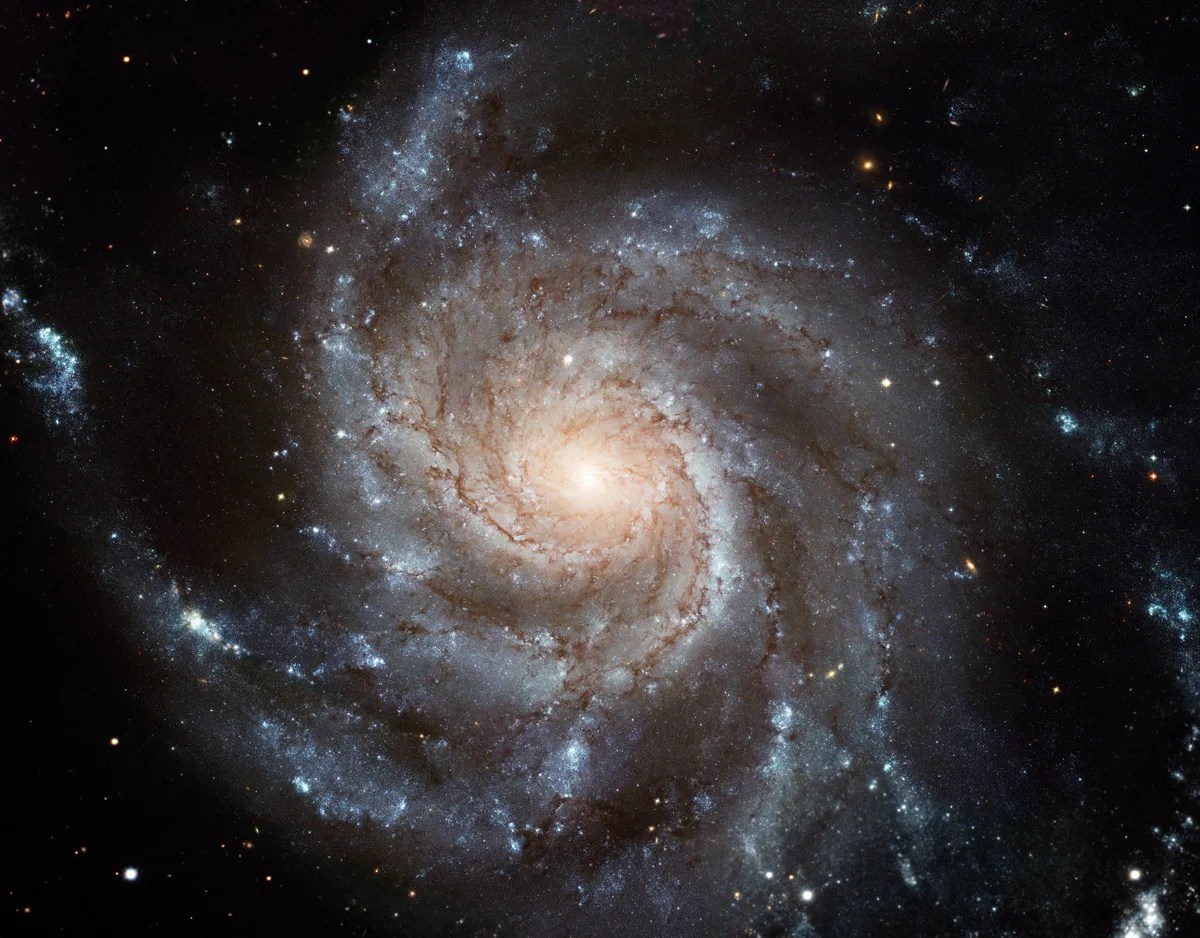

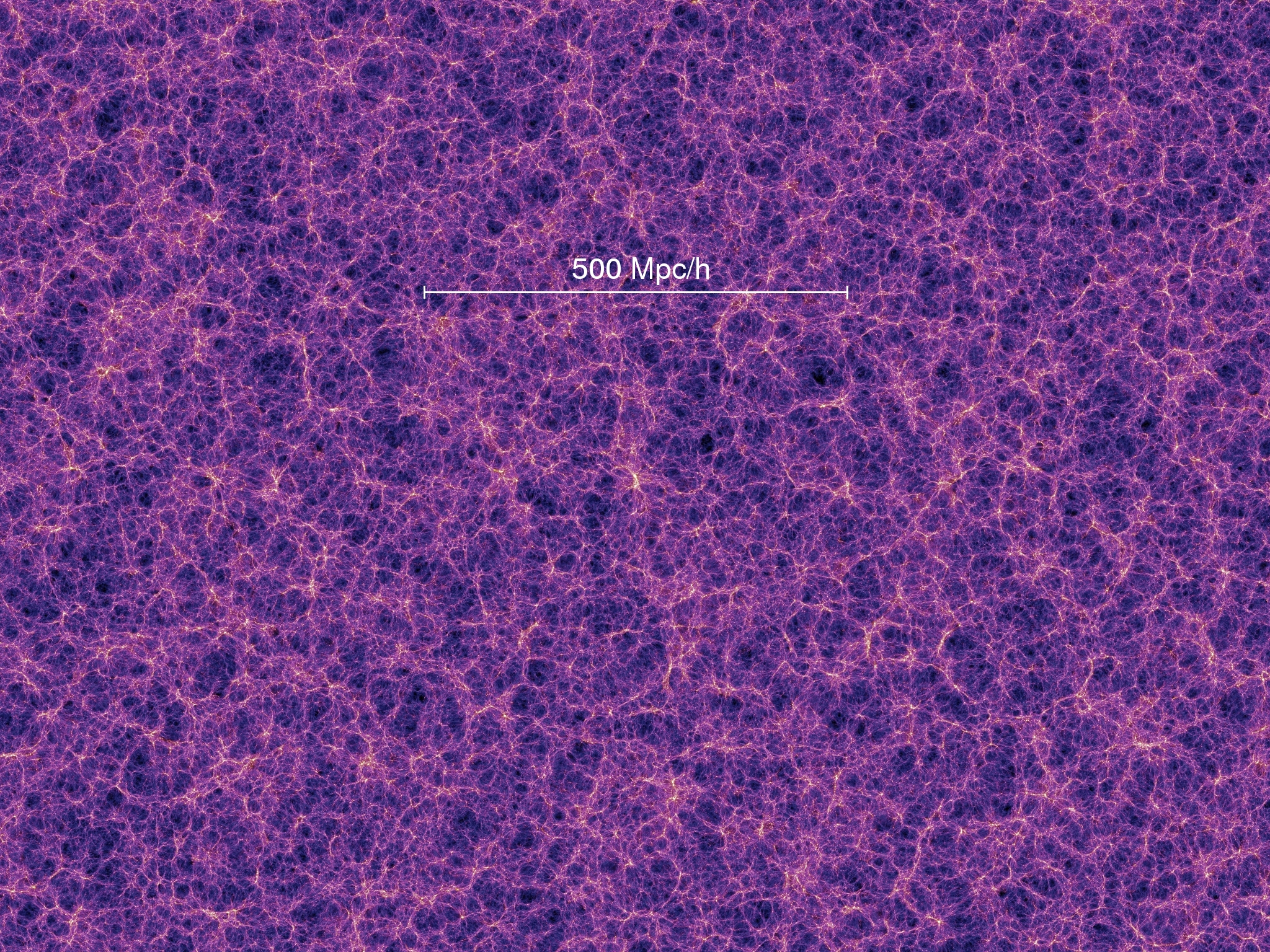
~ Gpc
pc
kpc
Mpc
Gpc
[Video credit: Francisco Villaescusa-Navarro]
Gas density
Gas temperature
Carolina Cuesta-Lazaro IAIFI/MIT @ IPMU 2024
Representation Learning
Informative abstractions of the data



Transfer learning beyond LCDM
Cosmic web Anomaly Detection
Representing baryonic feedback

Carolina Cuesta-Lazaro IAIFI/MIT @ IPMU 2024
What makes a good representation?
General
Predictive

Low dimensional?
Should generalize across scales, systems...
Transfer to unseen conditions
p(x|z)
Simple : Occam's razor
Causal?

Copernican
Ptolomeic
Carolina Cuesta-Lazaro IAIFI/MIT @ IPMU 2024
Representation Learning a la gradient descent
Contrastive
Generative
inductive biases
from scratch or from partial observations



Students at MIT are
OVER-CAFFEINATED
NERDS
SMART
ATHLETIC
Carolina Cuesta-Lazaro IAIFI/MIT @ IPMU 2024


Simulator 1
Simulator 2


Dark Matter
Feedback
i) Contrastive
Learning the feedback manifold
Baryonic fields
ii) Generative
Carolina Cuesta-Lazaro IAIFI/MIT @ IPMU 2024


Baryonic fields
Dark Matter
Generative model
Total matter, gas temperature,
gas metalicity





Encoder
Carolina Cuesta-Lazaro IAIFI/MIT @ IPMU 2024


Parity violation cannot be originated by gravity

["Measurements of parity-odd modes in the large-scale 4-point function of SDSS..." Hou, Slepian, Chan arXiv:2206.03625]


["Could sample variance be responsible for the parity-violating signal seen in the BOSS galaxy survey?" Philcox, Ereza arXiv:2401.09523]
Carolina Cuesta-Lazaro IAIFI/MIT @ IPMU 2024



Real or Fake?
x or Mirror x?
Carolina Cuesta-Lazaro IAIFI/MIT @ IPMU 2024

Train
Test

Me: I can't wait to work with observations
Me working with observations:
Very subtle effect -> Hard to find data efficient architectures
Carolina Cuesta-Lazaro IAIFI/MIT @ IPMU 2024

1. There is a lot of information in galaxy surveys that ML methods can access
2. We can tackle high dimensional inference problems so far unatainable
3. Our ability to simulate limits the amount of information we can robustly extract
Hybrid simulators, forward models, robustness
Unsupervised problems
Mapping dark matter, constrained simulations... Let's get creative!
Generative Models = Fast emulators + Field level likelihoods


Conclusions
Symmetries can help reduce number of training simulations
Carolina Cuesta-Lazaro IAIFI/MIT @ IPMU 2024

Small
Large
In-Distribution
In-Distribution
In-Distribution
Out-of-Distribution
Out-of-Distribution
Out-of-Distribution
Out-of-Distribution
Out-of-Distribution
Out-of-Distribution
Carolina Cuesta-Lazaro IAIFI/MIT @ IPMU 2024
APEC-Seminar2024
By carol cuesta
APEC-Seminar2024
- 445

